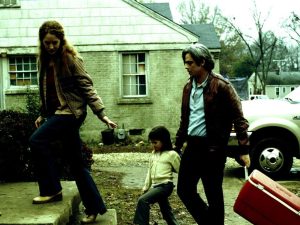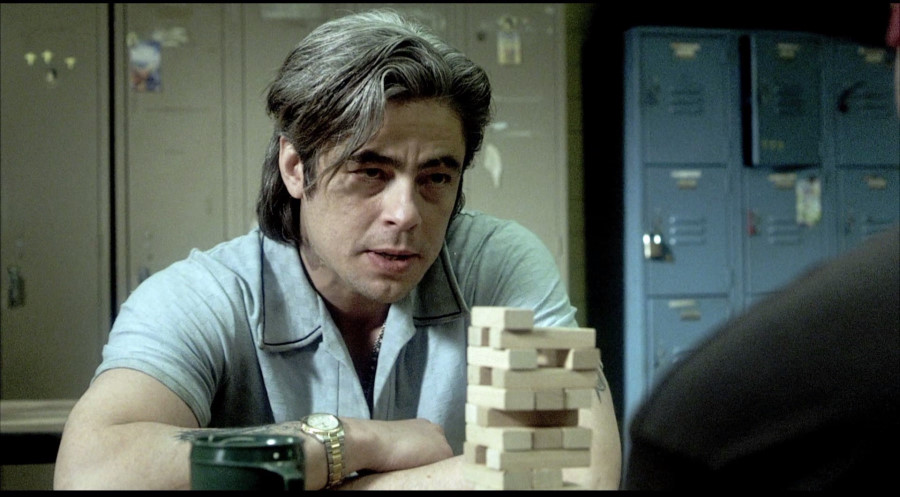Alejandro Gonzalez Inarritu’s 21 Grams is not a perfect film, but in its own way, and on its own terms, it is some kind of masterpiece. I don’t throw that word around lightly and realize it has been as abused and degraded as “genius” or “hero,” but when a film stakes a firm claim for the experimental — or risks failure and ridicule through sheer boldness — I will praise it in spite of its faults, although with 21 Grams there are very few indeed. It is true that if told in a conventional, linear fashion, 21 Grams might not register at all, although the performances by Naomi Watts, Sean Penn, and Benicio Del Toro are strong enough for any story.
It is also true that some of what we see, from the recipient of a heart transplant who seeks the donor’s family, to the career criminal who finds Jesus only to lose him again after a trial by fire, is not newly discovered by Inarritu. And yet, the film stands as one of the year’s most challenging experiences in a movie theater because it has the courage to be morbid, the balls to be confusing, and the sheer will to pursue the somber and the depressing in spite of an audience’s need to have relief.
Certain things do occur near the end of this film that could be interpreted as “redemptive” or as closure, but I have to wonder that if by concluding the film in such a way, Inarritu has granted us only a temporary reprieve; a moment’s diversion before realizing that in effect, nothing has changed because the characters — like members of the audience — must continue to struggle with their pain and tragedy. This is one of a small group of films each year that creates the illusion that lives go on after the closing credits and no, all is not well or secure.

Inarritu’s structure — from flash forwards, to flashbacks, to snippets of reality that might be illusion — is vital for a story of this nature, because understanding is not achieved by discovering secrets or the revelation of plot, but rather through emotional connection. That is not to say that this is a manipulative or maudlin piece, as so many films are that appeal to the heart at the expense of the head, but rather we empathize with the characters because we know what is to come and that with each tentative smile, there is little but sadness around the corner.
The essence of tragedy, I believe, is when a character is doomed, but such knowledge is unknown to that character yet revealed to the audience. As we watch, therefore, we cannot help but feel more deeply as we are forced to endure in silence, unable to prevent what must come next. We must sit as passively as the god of 21 Grams, a being who is believed in, but remains impotent and unable to alter the course of life. God can be treasured, appealed to, even given credit for good fortune, but in the end, events unfurl as a result of “choices,” some of which are driven by a need to achieve a desired result, and others with no particular logic whatsoever.
Take Del Toro’s character — a Jesus freak whose truck, believed to be an instrument of God, runs down a father and his two daughters, killing all three. Moments before, Del Toro had been making the right decisions for himself — looking for honest work despite facing discrimination, and holding to his avoidance of alcohol. Leaving a restaurant at that exact moment is why those three people died, and also why Sean Penn’s character received a heart and why he met Naomi Watts and why they found a brief moment of joy….and on and on.
It is interesting to surmise that had Del Toro broken his pledge and had a few drinks, those three people would still be alive as even a 10-15 second delay would have allowed the family to cross the street safely. Or maybe a few drinks would have made him paranoid and he would have taken a different route to avoid the police. Any number of scenarios are possible, but because we know what happens, we are forced to watch people die and lives forever altered with a sick helplessness.
That very randomness — that we can “do the right thing” throughout our lives and still end up hurt, killed, or hopelessly bereft — is Inarritu’s grandest theme, but it is not his only revelation. Perhaps most of us realize that for the most part, we are powerless to prevent tragedy and that “choice” is largely illusory, but whenever I see such a philosophical belief expressed on screen, I am encouraged because one of the most difficult fights we face in this country is the Americanism that each individual controls his or her destiny; that one’s success depends solely on one’s talents or lack thereof.
I am convinced that most of us can sleep nights only because we have internalized such a patently false view of life, and that to strip us of such false comforts is the same as producing the papers at last that validate a godless universe. After all, what is the first question we ask when we lose a loved one or face circumstances that seem so decidedly unfair? Why me? We continue: What did I do to deserve this? As if God himself is an accountant who tabulates our generosities and transgressions and disperses rewards and punishments on that basis. To quote Will Munny in Unforgiven, “Deserve’s got nothing to do with it.”

The story involving Penn and his failing health (and relationship) is, of course, also connected in that the death of Watt’s husband provides him with a new heart. Again, in a vicious, but quite realistic “twist of fate,” the heart is soon rejected and Penn faces death once again. So, while we might look upon the death of a man as “meaningful” in that it gave another man new life, such joys are fleeting as the recipient dies anyway. Inarritu is not being cruel, but simply pointing out that happiness is not only temporary, but can turn to tragedy before we have even registered that we were feeling content. It is even possible (and highly likely) that our very need to instill meaning in life and death is the very peak of foolishness. If someone died for a “reason,” does that really alter how we might feel? Think about how we invest so much in the lives of soldiers who die in Iraq, for example. We must tie abstractions like “freedom” and “justice” to their expirations because otherwise, we wouldn’t know how to proceed.
Or even worse, we might start asking questions, both of our leaders and our belief systems. Better that we salute them, slap medals on their corpses, and submit to mourning rituals that act as predictable turns in a life that might otherwise not make sense. But at bottom, I don’t believe that the loss is any less tragic or painful if we ascribe meaning, only we are not yet ready to admit such things to ourselves. That fact only reminds me that despite the trappings of success and modernity, we are still quite primitive in our thinking regarding our own mortality.

And where has the film itself gone during all this? I contend that it is impossible to watch 21 Grams as mere entertainment because it is caught up in the battle of life itself. Still, despite the noble cause, it successfully navigates around pretentiousness, as it insists on inference rather than overt displays of its own importance. A lesser film would lecture us, or judge us for not heeding its warning. Instead, 21 Grams merely observes, confident of its representation of truth, but not at all smug in the belief that only it understands.
And the film reverses itself and plays with the chronology not to trick us, but rather to demonstrate that it doesn’t matter what happens in the end, but rather how we reach that point. And yes, it is quite clever in that such a structure removes predictability as a criticism. Of course we know what happens, so we are forced to attend to other matters rather than connecting the dots of a “story.” As a result, we are much more involved and as an audience we have more at stake. Life unfolds; and it is jumbled, dirty, and pathetic. And it is us.

